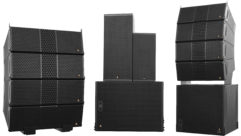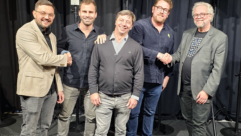Variety Is the Hallmark of Heinz
Feb 1, 2002 12:00 PM,
Keith Clark
Sound reinforcement for the bowl-shaped seating in large stadiums is typically achieved by one of two system approaches: a central loudspeaker cluster or a distributed loudspeaker system. The former supplies virtually all coverage from one point; the latter is designed to cover subdivided seating zones. Implemented correctly, both methods have been effective in meeting the coverage and performance requirements of stadiums, so choosing one or the other usually boils down to customer preference, budget and the physical and architectural parameters of the venue.
At Pittsburgh’s Heinz Field, sound designers implemented a system that uses both approaches. The 65,000-seat open-air venue serves as the new home for the National Football League’s Pittsburgh Steelers as well as for the football team of the University of Pittsburgh. It is located adjacent to where Three Rivers Stadium once stood and to the new PNC Park, which hosts Major League Baseballs’ Pittsburgh Pirates.
The seating configuration in Heinz Field resembles that of other large football stadiums constructed in the past decade: Main upper and lower seating levels, split by two levels of luxury suites and club seating, extend the full length of the long sides of the rectangular field. One end zone (to the north) is closed by a span of upper and lower seating decks, while a large scoreboard and video screen structure resides at the open (south) end.
From the outset, Dallas-based design firm Wrightson Johnson Haddon & Williams partnered with the client (Sports & Exhibition Authority of Pittsburgh and Allegheny County, and the Steelers) and the architectural firm (HOK Sports Facilities Group) to devise a system solution. WJHW had the advantage of entering the project at its formative stages, communicating with HOK Sports early on. WJHW senior consultant Jack McCallum served as project manager and was joined later by Washington Professional Systems of Wheaton, Maryland. They handled system implementation and custom engineering services. As usual with a project of this scope, the equipment manifest alone spans several pages, owing to both the complexity of the task and the wide selection of tools needed to achieve the desired results.
“The client sought a central cluster for the stadium, although there was some discussion very early about looking at a distributed system,” McCallum says. “Regardless, the overall goal was full-bandwidth output with even coverage and the requisite sound pressure levels for an application of this type. This can be achieved through either method, but budget was a primary consideration. A central cluster system tends to cost less than its distributed counterpart, requiring fewer devices and less infrastructure and installation labor.”
But as the project developed, two factors contributed to turning the sound design toward a hybrid approach. The design team and the client had to consider noise concerns expressed by a nearby historic neighborhood. Part of the solution came with the use of an extra-high canopy that rises a full 70 feet from the back of the upper decks of both long sides, offering plenty of latitude for distributed loudspeakers. Also of concern were gaps between the long sides of the upper deck and the end-zone upper deck, where sound energy could escape unabated. It was decided that the cluster could accurately deliver focused energy on the entire end zone, but trying to work around the gaps to supply premium coverage to the side upper decks would be problematic. This led to the use of some distributed speakers, which are mounted on a catwalk on the canopy and cover the rear 20 rows of seating. Keeping the energy generated by the cluster focused well below the top seating rows helps abate sound leakage outside the confines of the bowl.
MAIN CLUSTER OPTIONS
the open, south end zone at Heinz Field presented the most logical — and most optimal — location for the central cluster specified to cover 85% of the bowl, including the far-north-corner end-zone seats approximately 780 feet away. McCallum performed EASE modeling of the space, gathering data for the central cluster coverage and for location, coverage angles and transition zones of the distributed portion. McCallum notes that very few single-point loudspeaker options exist that can supply even, coherent, full-bandwidth coverage at the tremendous distances and wide directivity ranges typical of stadiums. But from this small group of options he chose Eastern Acoustic Works’ KF900 Series loudspeakers to form the single cluster that would reside on a custom platform above the scoreboard and video screens.
Working with the architect, WJHW was able to have a steel thrust attached above the scoreboard to get the cluster out away from the structure, helping to form the appropriate cluster arc needed for optimum performance. This also curtailed the potential shadowing effects of standard platforms. The top loudspeakers in the cluster are only a few feet below the top seats in the north end-zone deck. There was some discussion in the early stages about placing the cluster in the north end zone, thereby directing its coverage away from the residential area. However, this approach would have required much more structure and added layers of complexity and logistics, such as the need for numerous fill loudspeakers to cover the areas beneath the structure.
McCallum collaborated with EAW’s David Gunness on the design of the KF900 cluster, which is based on the company’s proprietary phased point-source technology (PPST). In brief, all horns and drivers of each loudspeaker are placed as close together as possible so that, in multiple arrays, they act as either a line array in the vertical plane or as a point source in the horizontal plane. Close spacing of the drivers also makes for relatively compact enclosures. Advanced digital processing allows the coverage pattern to be fine tuned, with the vertical axis actually steered. Thus, control in the horizontal plane is largely achieved with horn acoustics, while in the vertical plane it’s done mostly with electronics.
This project marks the first time a monolithic KF900 Series array has been deployed with an end-zone scoreboard location at a stadium in the United States, although this approach has been successfully used in Europe several times. Previous KF900 domestic installed stadium systems featured split array designs, effective in performance but not nearly as desirable given the benefits that can be realized by close coupling of each speaker when optimized via the PPST process.
The mid/high devices within the cluster, split by subwoofer columns, are left and right mirror images of each other in content and shape. Both sides are made up of three vertical columns of loudspeakers, with their trapezoidal enclosures tightly packed to form a natural arc. Each vertical column includes four loudspeakers, with a KF910 long-throw, high-frequency module at the top (five 2-inch drivers) and a specialized KF913 medium-throw downfill module (three 2-inch horn-loaded drivers) next. The bottom two rows in each column are held by KF920 long-throw, mid-frequency modules (three 10-inch horn-loaded drivers).
Two tightly packed vertical columns of subwoofers, each containing six EAW BH822E units, are centered within the cluster grid. These subs each have dual 12-inch woofers loaded on a proprietary bent bass horn. Frequency response is 24 to 300 Hz (±3 dB), and peak SPL is listed at 145 dB (1W/1m). “Being able to have two blocks in the cluster, with the subs down the center, provides full capability from the cluster, due to coherent coupling of the boxes,” EAW’s Gunness notes. “Fortunately, Jack [McCallum] was involved early in the project, reserving the appropriate space for the best cluster configuration. This is the way these loudspeakers should be placed, and both WJHW and the architect [HOK] are to be complimented for making it happen.”
While all of this was being designed, Washington Professional Systems engineered a custom frame that interlocks each row and column of the weatherproofed loudspeakers in place, and each individual module is strapped down by its rigging points. The cluster structure is bolted to the deck and attached at the top to structural steel. “WPS did an outstanding job of securing the cluster,” McCallum notes. “It’s very solid.”
Getting all of the loudspeaker elements to work together to supply the desired output, coverage and precision took special attention to processing parameters. At this point, Gunness got busy on his part of the project.
STEERING TECHNOLOGY
wjhw supplied Gunness with all modeling information, explaining where coverage needed to be and where it didn’t, plus the array location, elevations, etc. Armed with this crucial information, Gunness employed a software program he developed called F-Chart that helps make the complex calculations that are translated into equalization, crossover, delay and level settings for the cluster.
“The bottom line is that you’re able to steer the mids and highs very well with this technology,” McCallum says. “And all of the elements are successfully merged to supply full-bandwidth coverage right where you want it, that is, in each and every seat. At throw distances approaching 800 feet, this isn’t something you accomplish with just a few horns and drivers.” The outputs of mid-frequency and high-frequency loudspeaker modules are combined in the PPST process and assigned specific coverage areas throughout the bowl. Again, close coupling of all loudspeakers creates the effect of a single, giant loudspeaker largely devoid of transition points between modules.
“One of the neat parts of this project was controlling the energy of the cluster. I had done my preliminary steering calculations assuming that we were covering the whole stadium, including the uppermost portions of the side grandstands,” Gunness notes. “This changed by the time I arrived on-site to work with Jack on applying the settings, so we re-adjusted on the spot. We’ve always gone for full coverage with KF900 systems in the past. But, walking up the grandstand, there was a specific, consistent point where levels dropped by at least 10 dB, and this was the transition point to distributed coverage. This type of steering precision is a handy tool.”
The project also marked the first time the bent-horn-loaded BH822E subwoofers have been permanently installed in a U.S. stadium. The stack, six high by two wide, reaches 16 feet high, which offers good control down to very low frequencies. The flip side is that it’s also capable of beaming, which is eliminated in the steering process. In general, the horn-loaded design and the processing are merged to supply decent directionality, particularly for low-frequency information. “The subs are pretty amazing,” McCallum says. “They keep up with the system very well in terms of coherent arrival. Also, we found that these subs clip on the amps at about the same point as the mid-frequency boxes, so they’re efficient.”
MERGING THE TWO
at the outset of the tuning process, each loudspeaker in the cluster was assigned its own EQ, level and delay settings. Later, the EQ was adjusted to better match the overall performance of the entire unit. Diminishing very-high-frequency performance at the far ends of the upper grandstands is compensated by a slight boost of these frequencies in the distributed system.
Once the main cluster was set, attention turned to optimizing the distributed loudspeaker system lining the top of the upper deck. Coverage is supplied by Community WET315 three-way passive loudspeakers housed in weatherproof enclosures. They are mounted horizontally relative to the coverage area and attached to the canopy catwalk. Each of these speakers, with a maximum required throw distance of approximately 30 feet, is assigned its own delay setting relative to the output of the cluster. Frequency response is essentially set to match that of the cluster, ensuring smooth transitions devoid of any noticeable change in response.
A few more small loudspeakers were positioned on the underside of the upper balcony, providing coverage to seats that might eventually be shadowed by large advertising signs on the face of the deck. The design team also established an optional system setting that deactivates the distributed system and focuses the cluster’s energy into the lower half of the bowl. This can be deployed for special events where the upper deck is not needed.
The SPL performance criterion for the system was set in the mid-90dBA range, with peak capability of 100 dBA SPL required at the furthest points from the cluster. This applied to full-bandwidth output, 40 Hz to 10 kHz. For system testing, McCallum used an SPL meter to capture level readings of 106 dBA at about 750 feet from the cluster. Measurements were done with “red” noise (music-spectrum pink noise) and a song by the rock band Creed. Gunness notes that the system level was still not maxed out at this point. “We set the system limiters according to the nominal levels of the amplifiers, but the amps weren’t turned up all the way,” he explains. “Theoretically, there is another 3 dB of gain that could be supplied; however, this won’t be necessary and won’t be done.”
ELECTRONIC NETWORKS
a climate-controlled room behind the platform structure houses the QSC Audio power amplifiers and BSS Audio FDS-366 processors driving the cluster. QSC PL6 amps are dedicated to low- and mid-frequency loudspeakers, and QSC CX1102 amps handle the highs. All of these amps are on a QSControl networking system that allows system operators to monitor and control their status via PC in the system control position on the suite level.
The other primary system electronics room, located on the lower level of the north end-zone grandstand, also includes QSC amps on the QSControl network. These amps are dedicated to the distributed system: the small delay speakers and subsidiary systems covering concourses, restrooms, interview rooms and other areas. BSS Soundweb DSP units (networked as well) that reside at this location supply all processing for these sub systems, in addition to flexible source and signal routing capability.
The BSS FDS-366 processors can be controlled with another PC (shared by the Soundweb network) at the control position. Processor settings and amp channel assignment take advantage of the mirror-image cluster design. For example, the horn on one side of the cluster is given the same processor channel and amplifier channel in parallel with its twin on the other side. “Basically, there’s DSP for every output on half of the cluster, duplicated in parallel on the other side,” McCallum says. “It’s a lot of processing, but it drives the system to its fullest capability.”
A LynTec crowd compensation system (Crowd Comp), used with six remote microphones distributed around the stadium, provides some automatic gain riding relative to crowd levels. And an Aphex Dominator II has been inserted for overall brick-wall limiting of the system, helping to prevent overdriving. The control position is near the array, affording true primary field monitoring for the sound crew. A DDA Forum mixing console is posted at the front of the room, surrounded by a wide range of source devices including a Sound Creations Stadium Click FX digital system for quick find and play of tracks and sound effects, as well as two Denon CD players, a Tascam DAT machine, a Denon cassette tape player and a writeable CD player.
A Crown CM-311 headset microphone was specified with Sony headphones, intended for the stadium P.A. announcer. However, this could change, subject to the announcer’s preference. “It’s nice to have a mic that moves with its user, and we’ve had a lot of success with this particular unit in several other stadium projects. [CM-311s] reject noise pretty well,” McCallum adds.
Shure and Telex wireless systems are available for use during events on the field, with their receivers mounted in the control position. Patch panels for monitor wedges were also installed at field level. McCallum has spent a good deal of time in Pittsburgh over the past several years, working on the Heinz Field system and on that of the adjacent PNC Park. In light of these two projects, he reflects on the changes that continue to impact the stadium sound design and system marketplace: “It’s certainly not like the old days, when you had an EQ out front and a crossover, and you were pretty much good to go. I think everyone is still seeking a true comfort level with DSP, but it is remarkable and opens up a whole new world of solutions.”
“A good case in point is this project,” he says. “Control of sound is a major issue, and we’re able to do that quite well while still exceeding the stated objectives for the system. But, let’s face it, we’ll never control some factors like temperature, prevailing winds, noise from the adjacent highway, and so on. The advantage of modern tools is that they do help us overcome previous limitations, hopefully to the satisfaction of the client, the teams and the community.”
Keith Clark is an independent writer for the professional sound industry and has authored hundreds of system application articles.
For More Information
Aphex
aphex.com
Circle 224 on Reader Service Card
BSS Audio
www.bss.co.uk
Circle 225 on Reader Service Card
Community Professional
loudspeakers.net
Circle 226 on Reader Service Card
Crown Audio
crownaudio.com
Circle 227 on Reader Service Card
DDA
ddaconsoles.com
Circle 228 on Reader Service Card
Denon
del.denon.com
Circle 229 on Reader Service Card
EAW
eaw.com
Circle 230 on Reader Service Card
LynTec
lyntec.com
Circle 231 on Reader Service Card
QSC Audio
qscaudio.com
Circle 232 on Reader Service Card
Shure
shure.com
Circle 233 on Reader Service Card
Sony
sony.com/professional
Circle 234 on Reader Service Card
Sound Creations
soundcreations.com
Circle 235 on Reader Service Card
Tascam
tascam.com
Circle 236 on Reader Service Card
Telex
telex.com
Circle 237 on Reader Service Card










